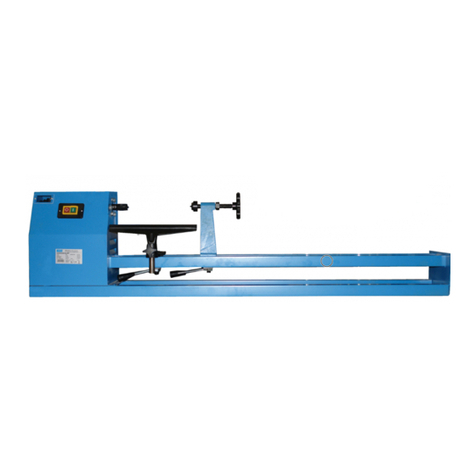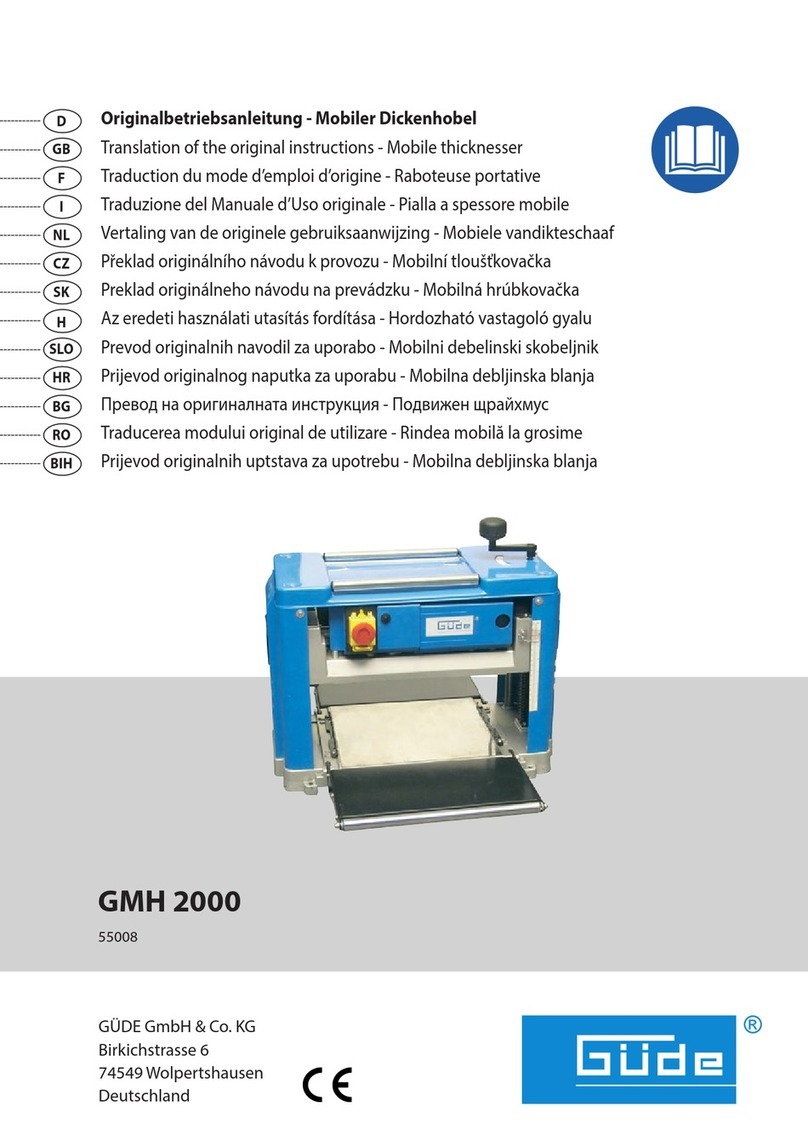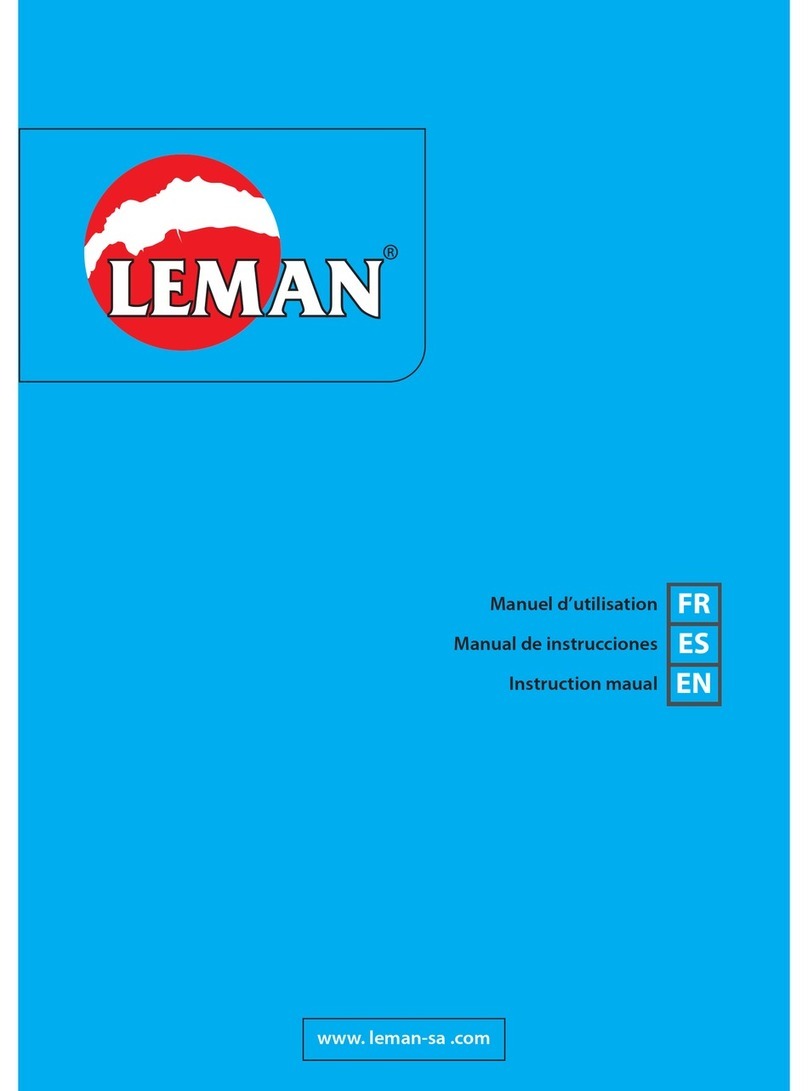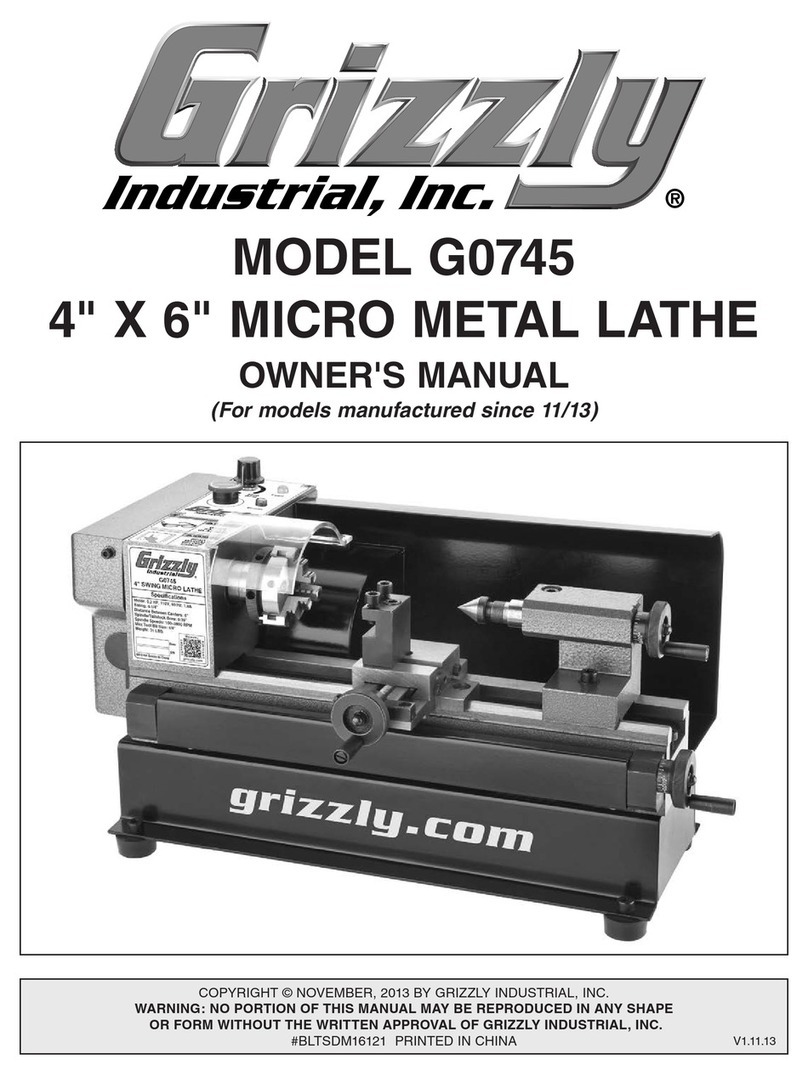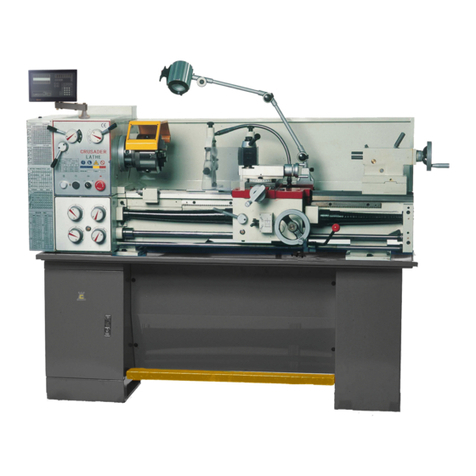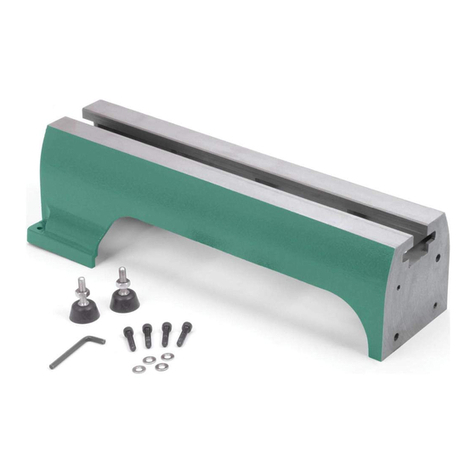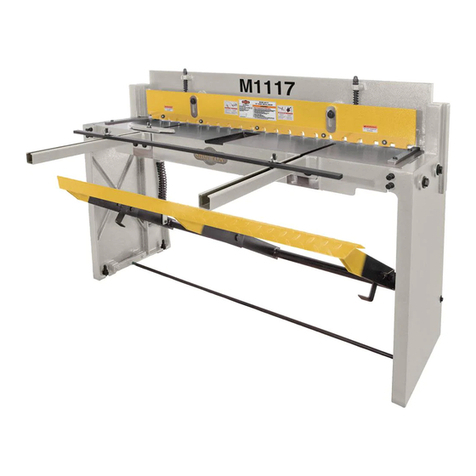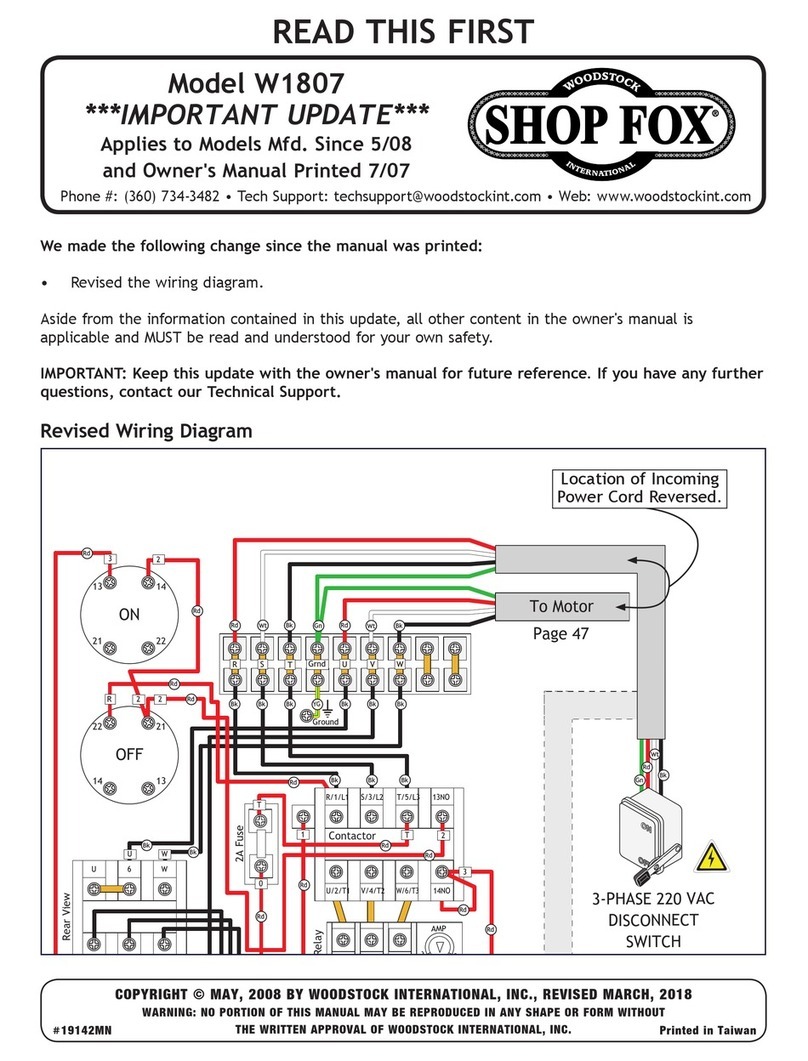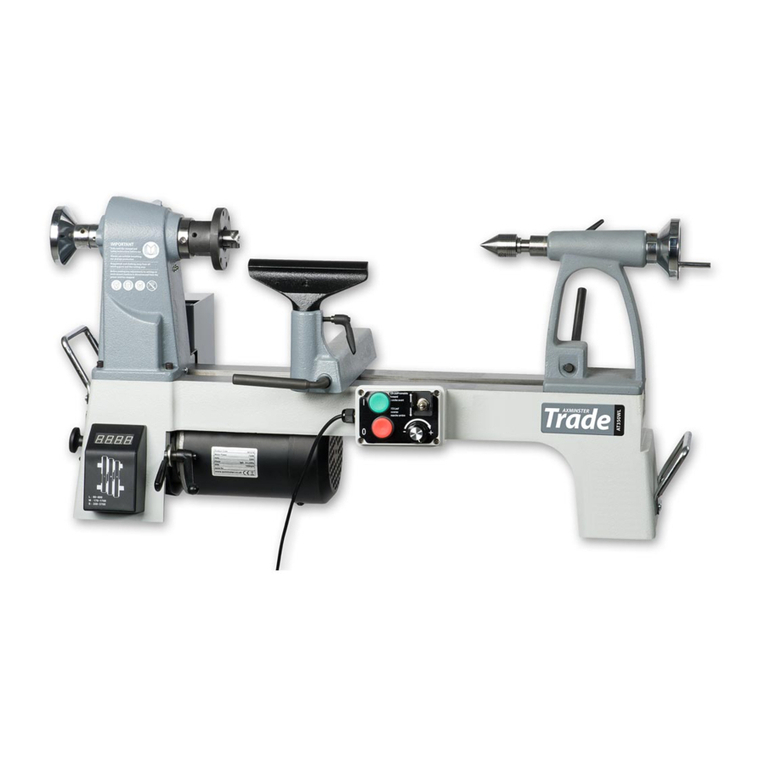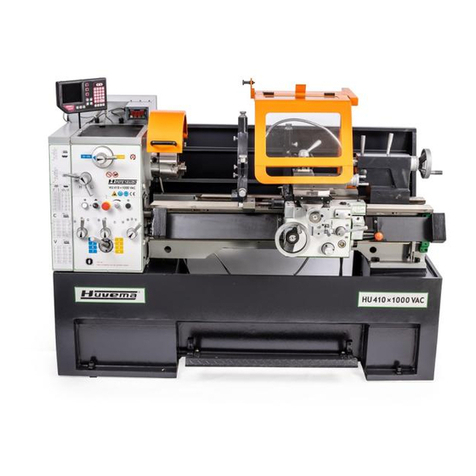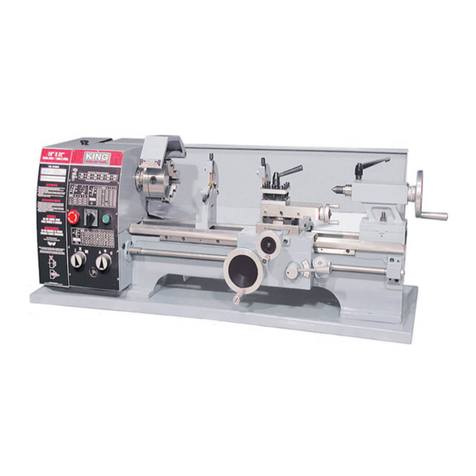Gude GDM 1000 Wiring diagram

GDM 1000
#11420
Deutsch D
Originalbetriebsanleitung
PROFI-DRECHSELMASCHINE
English GB
Translation of original operating instructions
PROFESSIONAL LATHE
Français F
Traduction du mode d’emploi d’origine
TOUR PROFESSIONNEL
Česky CZ
Originální návod k provozu
PROFESIONÁlNÍ SOUSTRUH
Nederlands NL
Vertaling van de originele gebruiksaanwijzing
PROFESSIONELE DRAAIBANK
MagyarH
Az eredeti használati utasítás fordítása
PROFI ESZTERGAPAD
©Güde GmbH & Co. KG - Birkichstrasse 6 - D-74549 Wolpertshausen - Deutschland

1
2
4
3 5 6
78
9
10
11
12
1
13
14
1516
16 17
2

3
4
5 6
7
8
9 10
DC
BA

11 Falsch Richtig
12
13
14
15
16 17

18
20
19
21
Ko
p
ierschablone
Fertiges
Werkstück
mit Kontur
der Schablone

Kennzeichnung
Produktsicherheit:
Produkt ist mit den einschlägigen
Normen der Europäischen
Gemeinschaft konform
Verbote:
Feuer, offenes Licht und
Rauchen verboten
Warnung:
Warnung/Achtung
Gebote:
Vor Gebrauch
Bedienungsanleitung lesen
Umweltschutz:
Abfall nicht in die Umwelt sondern
fachgerecht entsorgen.
Verpackungsmaterial aus
Pappe kann an den dafür
vorgesehen Recycling-Stellen
abgegeben werden.
Schadhafte und/oder zu
entsorgende elektrische oder
elektronische Geräte müssen an
den dafür vorgesehen Recycling-
Stellen abgegeben werden.
Verpackung:
Vor Nässe schützen Packungsorientierung Oben
Vorsicht zerbrechlich
Technische Daten:
Netzanschluss Motorleistung
Spitzenweite
Spitzenhöhe
Spindeldrehzahl
Drechseldurchmesser
Gewicht
Lieferumfang (Abb. 1 und 2)
1. Untergestell
2. Maschinenbett
3. Digitalanzeige
4. Reitstock
5. Zentrierspitze
6. Kopiereinrichtung
7. Werkzeugauflage
8. Mitnehmerspitze
9. Typenschild
10. Schalter
11. Motor
12. Vorschubkurbel
13. Planscheibe
14. Schlüssel
15. Ausstoßdorn
16. Kopiermesser
17. T-Schlüssel
18. Innensechskantschlüssel SW 3, SW 4
Bestimmungsgemäße Verwendung
Die Drechselmaschine ist ausschließlich zum bearbeiten
von Holz bestimmt.
Es dürfen mit dieser Maschine keine anderen Arbeiten
verrichtet werden, als die Arbeiten, für die die Maschine
gebaut ist und die in der Bedienungsanleitung beschrieben
werden. Jeder darüber hinausgehende Gebrauch gilt als
nicht bestimmungsgemäß. Für daraus resultierende
Schäden oder Verletzungen haftet der Hersteller nicht. Bitte
beachten Sie, dass dieses Gerät bestimmungsgemäß nicht
für den gewerblichen Einsatz konstruiert ist.
Gewährleistung
Die Gewährleistung erstreckt sich ausschließlich auf Mängel,
die auf Material- oder Herstellungsfehler zurückzuführen sind.
Bei Geltendmachung eines Mangels im Sinne der
Gewährleistung ist der original Kaufbeleg mit Verkaufdatum
beizufügen.
Von der Gewährleistung ausgeschlossen sind
unsachgemäße Anwendungen, wie z. B. Überlastung des
Gerätes, Gewaltanwendung, Beschädigungen durch
Fremdeinwirkung oder durch Fremdkörper. Nichtbeachtung
der Gebrauchs- und Aufbauanleitung und normaler
Verschleiß sind ebenfalls von der Gewährleistung
ausgeschlossen.

Wichtige Sicherheitshinweise
Die Bedienungsanleitung muss vor der ersten Anwendung
des Gerätes ganz durchgelesen werden. Falls über den
Anschluss und die Bedienung des Gerätes Zweifel entstehen
sollten, wenden Sie sich an den Hersteller (Service-
Abteilung).
UM EINEN HOHEN GRAD AN SICHERHEIT ZU
GARANTIEREN, BEACHTEN SIE AUFMERKSAM
FOLGENDE HINWEISE:
ACHTUNG!
•Der Arbeitsplatz muss sauber und ausreichend
beleuchtet sein.
•Betreiben Sie das Gerät nie in der Nähe von leicht
entflammbaren Materialien, Gasen oder Flüssigkeiten.
•Tragen Sie eine Schutzbrille, Gehörschutz und
geeignete Schutzkleidung. Falls notwendig zusätzlich
Staubschutzmaske tragen.
•Tragen Sie immer geeignete Kleidung. Tragen Sie
keine weite Kleidung oder Schmuck, sie könnten von
rotierenden Teilen erfasst werden. Rutschfestes
Schuhwerk wird empfohlen. Bei langen Haaren tragen
Sie ein Haarnetz.
•Nicht zu weit nach vorn beugen.
Sorgen Sie immer dafür, dass Sie sicher stehen und
das Gleichgewicht nicht verlieren
•Werkzeug nicht überbeanspruchen.
Das Werkzeug arbeitet besser und sicherer bei den
Parametern, für die es ausgelegt worden ist.
•Richtiges Werkzeug benutzen.
Werkzeuge oder Zusatzeinrichtungen nur für die
Zwecke benutzen, für die sie gedacht sind.
•Werkzeuge immer im guten Zustand halten.
Um optimale Ergebnisse zu erzielen und den
Arbeitsschutz zu gewährleisten, sind die Werkzeuge
immer scharf und sauber zu halten. Die
Schmieranweisungen und Anweisungen zum
Auswechseln von Zubehör sind einzuhalten.
•Sorgen Sie bei der Arbeit mit dem Gerät immer für
einen festen Stand.
•Halten Sie andere Personen, vor allem Kinder vom
Arbeitsbereich fern.
•Lassen Sie vorhandene Schutzvorrichtungen
grundsätzlich an ihrem Platz und stellen Sie deren
einwandfreie Funktion sicher.
•Überprüfen Sie regelmäßig, dass alle Verschraubungen
fest montiert sind.
•Vergewissern Sie sich, dass sich das Netzkabel nicht in
der Nähe von rotierenden Teilen befindet.
•Lassen Sie laufende Werkzeuge nicht unbeaufsichtigt.
Wenn Sie sich von dem Gerät entfernen schalten Sie
es aus.
•Nach der Benutzung Einstellschlüssel wegräumen.
Stellen Sie sicher, dass für die Einstellung verwendetes
Werkzeug immer weggeräumt wird, bevor die
Maschine eingeschaltet wird.
•Entfernen Sie immer den Netzstecker bei
Nichtgebrauch, vor Wartung/Reinigung oder beim
Werkzeugwechsel.
•Personen, die aufgrund ihrer physischen,
sensorischen oder geistigen Fähigkeiten oder Ihrer
Unerfahrenheit oder Unkenntniss nicht in der Lage
sind, das Gerät zu bedienen, dürfen das Gerät nicht
benutzen.
•Wenn das Gerät oder das Anschlusskabel sichtbare
Beschädigungen aufweisen, darf das Gerät nicht in
Betrieb genommen werden.
•Wenn die Netzanschlussleitung dieses Geräts
beschädigt wird, muß sie durch den Hersteller oder
einen Elektrofachmann ersetzt werden.
•Reparaturen an diesem Gerät dürfen nur von einem
Elektrofachmann durchgeführt werden. Durch
unsachgemäße Reparaturen können erhebliche
Gefahren entstehen.
•Für die Zubehörteile gelten die selben
Vorschriften.
Güde GmbH & Co. KG übernimmt keine Haftung für
Schäden aufgrund folgender Punkte:
•Beschädigungen am Gerät durch mechanische
Einflüsse und Überspannungen.
•Veränderungen am Gerät
•Verwendung für andere als die in der Anleitung
beschriebenen Zwecke.
•Beachten Sie unbedingt sämtliche
Sicherheitshinweise um Verletzungen und
Schäden zu vermeiden.
Verhalten im Notfall
Leiten Sie die der Verletzung entsprechend notwendigen
Erste Hilfe Maßnahmen ein und fordern Sie schnellst
möglich qualifizierte ärztliche Hilfe an.
Bewahren Sie den Verletzten vor weiteren Schädigungen
und stellen Sie diesen ruhig.
Für einen eventuell eintretenden Unfall sollte immer ein
Verbandskasten nach DIN 13164 am Arbeitsplatz
griffbereit vorhanden sein. Dem Verbandskasten
entnommenes Material ist sofort wieder aufzufüllen.
Wenn Sie Hilfe anfordern,
machen Sie folgende Angaben:
1. Ort des Unfalls
2. Art des Unfalls
3. Zahl der Verletzten
4. Art der Verletzungen
Entsorgung
Die Entsorgungshinweise ergeben sich aus den
Piktogrammen die auf dem Gerät bzw. der Verpackung
aufgebracht sind. Eine Beschreibung der einzelnen
Bedeutungen finden Sie im Kapitel „Kennzeichnungen auf
dem Gerät“.
Anforderungen an den Bediener
Der Bediener muss vor Gebrauch des Gerätes aufmerksam
die Bedienungsanleitung gelesen haben.
Qualifikation
Außer einer ausführlichen Einweisung durch eine
sachkundige Person ist keine spezielle Qualifikation für den
Gebrauch des Gerätes notwendig.
Mindestalter
Das Gerät darf nur von Personen betrieben werden, die das
16. Lebensjahr vollendet haben.
Eine Ausnahme stellt die Benutzung als Jugendlicher dar,
wenn die Benutzung im Zuge einer Berufsausbildung zur
Erreichung der Fertigkeit unter Aufsicht eines Ausbilders
erfolgt.
Schulung
Die Benutzung des Gerätes bedarf lediglich einer
entsprechenden Unterweisung. Eine spezielle Schulung ist
nicht notwendig.
Technische Daten
Anschluss: 230 V
Frequenz: 50 Hz
Max. Leistung P1: 550 W
Max. Drechselgutlänge: 935 mm
Spitzenhöhe: 140 mm
Spindeldrehzahl: 600 - 2100 min-1
Drechseldurchmesser: Max. 280 mm
Gewicht ca.: 70,5 kg

Transport und Lagerung
Das Gerät ist nur für den stationären Einsatz
konzipiert.
Unbenutzte Werkzeuge sollten in einem trockenen,
verschlossenen Raum aufbewahrt werden.
Sicherheitshinweise für die Inspektion und Wartung
Nur ein regelmäßig gewartetes und gut gepflegtes Gerät
kann ein zufriedenstellendes Hilfsmittel sein. Wartungs- und
Pflegemängel können zu unvorhersehbaren Unfällen und
Verletzungen führen.
Montage
Untergestell
Montieren Sie das Untergestell wie abgebildet (Abb. 3).
Achten Sie darauf, dass Sie die Schrauben nicht gleich
festziehen. Dadurch ist es einfacher die Montagebohrungen
zu positionieren und mit den Schrauben zu fixieren. (siehe
folgende Schemazeichnung)
Erst Füße am Untergestell mittels der mitgelieferten
Schauben und Muttern anbringen, dann die Maschine am
Gestell festschrauben.
Einführung
Grundsätzlich eignen sich härtere, kurzfaserige und
trocken abgelagerte Hölzer besser als weiche,
langfaserige und frische Hölzer.
Sehr gut geeignete Hölzer sind Obst, -Nuss, und
Laubholzarten. Bringen Sie das Holz am besten durch
Sägen auf die später benötigte Stärke (evtl. auch durch
Spalten). Es sollte ohne Sonneneinstrahlung trocken und
gut durchlüftet lagern.
Faustregel Trockenzeit: Pro cm Stärke = 1 Jahr.
So wird ein Reißen der Hölzer weitestgehend vermieden.
Vorbereitung
Drechselrohlinge oder -Hölzer müssen zwischen
Mitnehmerseite (Maschinenseite) und Mitlaufseite
(Reitstock) unwuchtfrei zentriert sein um Unfälle durch ein
eventuelles Losreisen des Werkstückes während der
Bearbeitung zu vermeiden!
Achten Sie darauf möglichst parallel zulaufende Rund- oder
Schnitthölzer zu verwenden. Ermitteln Sie das Zentrum Ihres
Rohlings durch Anreißen, in dem Sie mit einem Stift oder
einer Reissnadel mit Hilfe eines Lineales oder eines
Zentrierwinkels (optional erhältlich) den Mittelpunkt
feststellen. (Abb. 4)
Abb. 4 A + B:
Ermittlung des Zentrums über die Kanten des Rohlings
Abb. 4 C:
Ermittlung des Zentrums mittels eines Zentrierwinkels
Abb. 4 D:
Fixieren des Zentrums mit Hilfe eines Hammers und einer
Körnerspitze.
Grundbegriffe
Schruppen: Grobe und starke Materialabnahme am
Werkstück, um die Rohkontur herzustellen (Drehzahl 800-
1500 U/min.).
Schlichten: Geringe, feine Spanabnahme zur Herstellung
der Feinkonturen (Drehzahl 1500-2000 U/min.).
Schleifen: Endbearbeitung eines Werkstücks mittels
Schleifleine oder -Papier (Drehzahl 0-2000 U/min.).
Polieren: Bearbeitung des Werkstückes mittels Stoff oder
Flies unter Zugabe von Poliermitteln wie Pasten, Ölen,
Holzpflegemitteln oder Fetten (optional erhältlich).
Achtung!
Beim Bearbeiten des Werkstückes mit Schleif- und
Polierhilfsmitteln ist erhöhte Vorsicht durch auftretende
Adhäsionskräfte (Anhangskräfte) an den Hilfsmitteln
geboten!
Z.B.: Verletzungsgefahr durch erfassten und
mitgerissenen Stoff, Flies etc.
Montierte Drechselmaschine mit Untergestell (Abb. 1).
Fertig montierte Drechselmaschine mit eingespannter
Kopiervorlage (Abb. 5).
Montage des Kopierarms
Führen Sie den Kopierarm zwischen die beiden am Schlitten
befindlichen Haltelaschen und schieben Sie den Bolzen (Pos.
73) in die Lagerbohrung. Ziehen Sie Sie die Muttern
beidseitig an. (Abb. 6)
ACHTUNG: Nicht zu fest anziehen, der Arm muß beweglich
bleiben.
Montage des Vorschubrades
Stecken Sie das Vorschubrad auf die Schlittenachse.
Die Sicherung erfolgt durch die Innensechskant-schraube
am Bund des Vorschubrades. (Abb. 7)
Montage der Werkzeugauflage
Werkzeugauflagenträger und Grundplatte auf das
Maschinenbett montieren und festziehen. (Abb. 8)
Anschließend wird die Werzeugauflage mit der
Klemmschraube im Werkzeugauflagenträger fixiert.
(Abb. 9). Positionieren Sie die Werzeugauflage möglichst
nah am Werkstück.
Achtung!
Das Werkstück darf die Werzeugauflage beim Drechseln
nicht berühren. Drehen Sie vor Arbeitsbeginn das Werkstück
von Hand durch, um sicher sein, das es frei läuft.
Drechseln
Drehzahleinstellung
Dank des speziellen Getriebes mit variablen
Riemenscheiben ist die Drehzahl der Maschine stufenlos
verstellbar und erlaubt ein exaktes, analoges Einstellen der
Drehzahlen, die digital am Getriebe-gehäuse angezeigt
werden. (Abb. 10)
Die Drehzahl muss bei laufender Maschine
eingestellt werden, um das Riemengetriebe nicht
zu beschädigen.
Schruppen: 800-1500 U/min.
Schlichten: 1500-2200 U/min.
Achtung!
Bevor Sie die Maschine stoppen, immer vorher die Drehzahl
ganz
herunterfahren, das erleichtert den erneuten Anlauf.
Schruppen und Schlichten: Den Drechselbeitel wie
abgebildet auf die Werkzeugauflage auflegen und mit beiden
Händen fest und sicher halten, darauf achten, dass die
Spanabnahme auf Höhe der Mittelachse erfolgt und
genügend Spanwinkel vorhanden ist (Abb. 11). Verwenden
Sie nur exakt geschliffeneund scharfe Drechselwerkzeuge.
Entfernen der Mitnehmspitze
Zum Entfernen der Mitnehmerspitze führen Sie den
Ausstoßdorn von der linken Maschinenseite durch die
Spindelbohrung (Abb. 12) und stoßen die Mitnehmerspitze
kräftig aus dem Konus (dies gilt für sämtliche spannbaren
Werkzeuge mit Konusaufnahme MK2).

Drechseln mit Planscheibe
Zum Drechseln von Tellern oder Schalen entfernen Sie die
Mitnehmerspitze (Abb. 12) und drehen die Planscheibe auf
das Spindelgewinde.
ACHTUNG: Mit den beiden mitgelieferten Gabelschlüsseln
gut sichern!
TIPP: Den Rohling länger als notwendig absägen und mit
Schrauben an der Planscheibe befestigen.
(Zentrisch befestigen um eine Unwucht zu vermeiden!)
Kopierdrechseln
Zum Kopieren muss der Kopierarm zwischen Reitstock und
Mitnehmerspitze montiert werden. Um die Kopiereinrichtung
zwischen Reitstock und Mitnehmerspitze oder Planscheibe
zu positionieren, müssen die Klemmschrauben (Abb. 14) am
Reitstock entfernt und der Reitstock abgenommen werden.
Nun wird die Klemmplatte zerlegt indem man die beiden
Schrauben (Abb. 15) löst. Anschließend werden die Platten
entnommen (Abb. 16), hinter dem Kopierarm wieder
eingesetzt und der Reitstock montiert.
Das zu kopierende Original wird zwischen die
Zentrierspitzen der Kopieraufnahme gespannt. Nun kann
man die Zustellung (Anpressdruck des Kopierarmes) mit der
Spannschraube (Abb. 17) einstellen.
Das Kopiermesser wird am größten Durchmesser
eingestellt.
Das Werkstück wird auf die gesamte Länge der
Kopiervorlage gleichmäßig solange abgefahren bis keine
Spanabnahme mehr erfolgt.
Die Kopiermesser werden durch drehen am Handrad
nachgestellt und mit der Klemmschraube fixiert bis die
gewünschte Kontur bzw. der gewünschte Durchmesser
erreicht ist (Abb. 18).
Schablonendrechseln
Kopierschablonen lassen sich aus verschiedensten
Materialien herstellen, Sperrholz eignet sich hierzu gut. Die
Schablone gleicht der Kontur des zu drechselnden
Werkstücks. (Abb. 19).
Um eine Kopierschablone als Vorlage zu verwenden,
klappen Sie die Haltevorrichtung nach oben und sichern Sie
diese zwischen den Zentrierspitzen der Kopieraufnahmen
(Abb. 20).
Lösen Sie die Klemmschrauben der Andruckleiste
(Abb. 21) um die Schablone spannen zu können. Beim
Drechseln wird die Schablone so oft abgefahren bis die
gewünschte Kontur am Werkstück entstanden ist.
Service
Sie haben technische Fragen? Eine Reklamation?
Benötigen Ersatzteile oder eine Bedienungsanleitung?
Auf unserer Homepage www.guede.com im Bereich
Service helfen wir Ihnen schnell und unbürokratisch weiter.
Bitte helfen Sie uns Ihnen zu helfen. Um Ihr Gerät im
Reklamationsfall identifizieren zu können benötigen wir die
Seriennummer sowie Artikelnummer und Baujahr. Alle diese
Daten finden Sie auf dem Typenschild. Um diese Daten stets
zur Hand zu haben, tragen Sie diese bitte unten ein.
Seriennummer:
Artikelnummer:
Baujahr:
Tel.: +49 (0) 79 04 / 700-360
Fax: +49 (0) 79 04 / 700-51999
EG KONFIRMITÄTSERKLÄRUNG
Hiermit erklären wir,
Güde GmbH & Co. KG
Birkichstraße 6,
74549 Wolpertshausen,
Germany
Dass die nachfolgend bezeichneten Geräte aufgrund ihrer
Konzipierung und Bauart sowie in den von uns in Verkehr gebrachten
Ausführungen den einschlägigen, grundlegenden Sicherheits- und
Gesundheitsanforderungen der EG-Richtlinien entsprechen.
Bei einer nicht mit uns abgestimmten Änderung der Geräte
verliert diese Erklärung ihre Gültigkeit.
Bezeichnung der Geräte: GDM 1000
Artikel-Nr.: 11420
Datum/Herstellerunterschrift: 16.09.11
Angaben zum Unterzeichner: Hr. Arnold, Geschäftsführer
Technische Dokumentation: J. Bürkle FBL; QS
Einschlägige EG-Richtlinien:
2004/108/EC
2006/42/EC
Angewandte harmonisierte Normen:
EN 55014-1
EN 55014-2
EN 61000-3-2
EN 61000-3-3
EN ISO 14121-1
EN 61029-1

Signs on Unit
Product Safety:
Product compliance with respective
EU standards
Bans:
No fire, no open fire and no
smoking
Warning:
Warning/Caution
Commands:
Read instruction manual before
use
Environment Protection:
Wastes to be disposed of in a
professional manner not to harm
the environment.
Cardboard packaging to be
collected for recycling.
Faulty and/or disposed of
electrical/electronic appliances to
be collected by authorised salvage
places.
Packaging:
Keep away from moisture The package should be held
upwards
Fragile
Technical Data:
Connection Motor power
Point wide
Point height
Spindle revolutions
Max. turning length
Weight
Scope of Delivery (Fig. 1 and 2)
1. Stand
2. Machine Bed
3. Digital Indicator
4. Tailstock
5. Centring Point
6. Copying Device
7. Tool Support
8. Carrier Tip
9. Rating Plate
10. Switch
11. Motor
12. Shifting Handle
13. Face Plate
14. Wrench
15. Ejecting Broach
16. Copying Tool
17. T-wrench
18. Allen Wrench SW 3, SW 4
Use as designated
The lathe is working on exclusively for wood intended.
The machine cannot be used for works other than for which
it has been designed and that are specified in the Operating
Instructions. Any other use is a use in conflict with the
designation. The manufacturer will not be liable for any
consequential damage and injuries. Please be sure to know
that the machine has not been designed for industrial
purposes.
Guarantee
The guarantee solely covers inadequacies caused by
material defect or manufacturing defect.
Original payment voucher with the sales date needs to be
submitted for any claim in the guarantee period.
The guarantee does not cover any unauthorised use such as
appliance overloading, use of violence, damage as a result
of any unauthorised interference or caused by foreign items.
Failing to follow the operating and assembly instructions and
common wear are also not included in the guarantee.

General Safety Instructions
Prior to the initial use of the unit, the operating instructions
should be read completely. If in doubt with regard to
connection and operation of the unit, consult the
manufacturer (servicing department).
FOLLOW THE INSTRUCTIONS BELOW CAREFULLY IN
ORDER TO SECURE A HIGH DEGREE OF SAFETY:
CAUTION!
•The unit shall always be fitted on the worktable
horizontally, safely and firmly.
•The workplace shall be kept clean and sufficiently lit.
•Never use the unit near easily flammable materials,
gases or liquids.
•Wear goggles, ear protectors and suitable protection
clothing. If necessary, use a breathing mask.
•Do not lean far forward.
Always take care that your posture is safe and avoid
losing your balance
•Do not overload the machine.
The machine operates better and safer under conditions
for which it was designed.
•Use proper tool.
Tools or auxiliary equipment should be used only for the
purpose for which they were intended.
•Always keep tools in good conditions.
•To achieve optimum results and ensure safety during
work it is essential to keep tools always sharp and
clean. It is necessary to meet instructions for lubrication
as well as for replacement of accessories.
•Make sure that your standing is stable when working
with the unit.
•Keep unauthorised persons, children in particular, away
from the working area.
•Keep the existing protection devices at places and
provide for their perfect functioning.
•Make sure that the power cable is not close to rotating
parts.
•Never leave the switched-on unit unattended. If you
depart from the unit, switch it off.
•If the unit is out of use, prior to maintenance/cleaning or
replacement of a tool, unplug it.
•After use, put away the adjusting key.
•Make sure that cleared for the setting tool used always,
before the machine is turned on.If the unit is out of use,
prior to maintenance/cleaning or replacement of a tool,
unplug it.
•Persons unable to operate the appliance due to their
physical, sensory or mental abilities or their
inexperience or lack of knowledge must not operate it.
•If the appliance or feeder cable show any sign of visible
damage the appliance must not be put into operation.
•If the feeder cable of the appliance is damaged it needs
to be replaced by the producer or an electrician.
•Repairs of the appliance can only be executed by an
electrician. There might be significant risks as a result of
unauthorised repairs.
•The same regulations apply for accessories.
Güde GmbH & Co. KG does not answer for damages
caused by:
•Appliance damage by mechanical influences and
overloading.
•Any changes to the appliance.
•Use for any other purpose than that described in the
Operating Instructions.
•Unconditionally follow all safety instructions to prevent
accidents and damage.
Emergency procedure
Conduct a first-aid procedure adequate to the injury and
summon qualified medical attendance as quickly as possible.
Protect the injured person from further harm and calm them
down.
For the sake of eventual accident, in accordance with
DIN 13164, a workplace has to be fitted with a first-aid kit.
It is essential to replace any used material in the first-aid
kit immediately after it has been used.
If you seek help,
state the following pieces of information:
5. Accident site
6. Accident type
7. Number of injured persons
8. Injury type(s)
Disposal
The disposal instructions are based on icons placed on the
appliance or its package. The description of the meanings
can be found in the “Marking” chapter.
Operating staff requirements
The operator must carefully read the Operating Instructions
before using the appliance.
Qualification
No special qualification is necessary for using the appliance
apart from detailed instruction by a qualified person.
Minimum age
The appliance may only be operated by persons over 16
years of age. An exception includes youngsters operating
the appliance within their professional education to achieve
necessary skills under teacher's supervision.
Training
Using the appliance only requires appropriate instructions by
a professional or reading the Operating Instructions. No
special training necessary.
Technical data
Connection 230 V
Frequency: 50 Hz
Motor power P1: 550 W
Max. turning length: 935 mm
Point height: 140 mm
Point wide: 600 - 2100 rev/min-1
Turning diameter: Max. 280 mm
Weight: 70,5 kg
Transportation and Storage
The unit has been designed for stationary use.
Units out of use should be stored in a dry locked room.
Inspection and Maintenance Safety Instructions
The machine will serve as a sufficient aid only if maintained
and care for appropriately. Insufficient maintenance and care
may result in accidents and injuries.

Assembly
Stand
Assemble the stand according to the figure.(Fig. 3). Take
care that screws are not tightened at the same time. Thus it
is easier to position mounting holes and fix the screws. (See
the following schematic drawing)
Introduction
On principle short-fibred harder wood stored in a dry place
is more suitable than long-fibred soft fresh wood.
Wood from fruit and leafy trees and walnut trees are very
suitable.Prepare the wood preferably by saw cutting for the
thickness later required (possibly also by splitting). It
should be stored without sun radiation in a dry and
properly ventilated room.
Approximate rule for wood drying: for the thickness of 1
cm = 1 year.
Thus one can avoid wood cracking by far.
PREPARATION
Unmachined pieces or wood to be turned must be balance
centred between carrying side (machine side) and the side
of collateral run (tailstock) to avoid accidents as a result of
possible tearing the workpiece off during machining! Pay
attention using roundwood or timber coming in parallel
direction if possible.
Determine the centre of your unmachined piece by drawing
whilst determining the centre using a pin or marking awl and
using the ruler or centring angle (available as optional
accessory). (Fig.. 4)
Abb. 4 A + B:
Centre location over the unmachined piece edges
Abb. 4 C:
Centre location using the centring angle (available as an
optional accessory)
Abb. 4 D:
Centre fixation using a hammer and centre punch
Basic terms
Roughing: Thick and strong removal of workpiece material
to form a rough contour (revolutions 800-1500 rev/min.).
Smoothing: Tiny, fine chip removal to produce fine contours
(revolutions 1500-2000 rev /min.).
Grinding: Final working up the workpiece using abrasive
rope or paper (revolutions 0-2000 ot./min.).
Polishing: working up the workpiece using a cloth or fleece
with allowance of polishing agents – pastes, oils, agents for
wood treatment or greases (available as optional accessory.
Attention!
Pay more attention to machining of a workpiece with
grinding and polishing agents due to adhesive forces
generated on instruments!
E.g.: Risk of accident resulting from captured and torn
off cloth, fleece etc.
Assembled lathe with stand (Fig. 1).
Finally assembled lathe with clamped copying template (Fig.
5).
COPYING ARM INSTALLATION
Insert the copying arm between both holding butt straps
located at the slideand shift the joint pin (item 73) to the
bearing opening. Tighten nuts at both sides (Fig. 6)
ATTENTION: Do not tighten too firmly, the arm should stay
movable.
SLIDING WHEEL INSTALLATION
Shiftthe sliding wheel to the sled axis.
Securing is done using the Allen screw at the circumference
of the sliding wheel (Fig. 7)
TOOL SUPPORT INSTALLATION
Mount the supporting tool holder and base plate to the
machine bed and tighten. (Fig. 8) Then the tool support is
fixed by clamping bolt in the supporting carrier of the tool
(Fig. 9). Place the tool support as close to
the workpiece as possible.
Attention!
The workpiece must not be in contact with the tool support
during turning. Turn the workpiece by hand before you
start the work to ensure it runs freely.
Turning
REVOLUTION ADJUSTMENT
Thanks to the special gearbox with variable belt pulleys the
machine revolution can be adjusted continuously allowing
exact analogue adjustment of revolutions being indicated in
digital form at the gearbox. (Fig. 10)
Revolution adjustment must be performed on running
machine to avoid the damage of the belt gearbox.
Roughing: 800-1500 U/min.
Smoothing: 1500-2200 U/min.
Attention!
Always lower the machine revolutions to the minimum value
before its stopping; its starting again will be made much
easier thus.
Roughing and smoothing: lay the turning chisel – see the
figure – down on the tool support holding it with both hands
firmly and safely and take care that chip removal takes place
at the central axis height and sufficient stressing angle is
available (see schematic drawing). Use only exactly
sharpened and sharp turning tools. (Fig. 11).
CARRYING POINT REMOVAL
To remove the carrying point direct the ejecting broach from
the left side of the machine through spindle hole (Fig. 12)
and strike the carrying point strongly from the cone (this also
holds for all clampable tools with conical grip MK2)
TURNING WITH FACE PLATE
To turn plates or bowls remove the carrying point (Fig. 12)
and turn the face plate to the spindle thread.
ATTENTION: Secure well using both bifurcated wrenches
that make part of the delivery!
TIP: Unmachined piece should be cut longer than necessary
and fixed to the face plate with screws. (Fix it in the centre
to avoid improper balancing!)
Copying turning
For copying the copying arm must be installed between
tailstock and carrying point. To place the copying device
between tailstock and carrying point or face plate the
gripping screws on the tailstock must be dismounted
(Fig. 14) and the tailstock must be removed.
Now the gripping plate should be split by loosening both
screws (Fig. 15) Having this done the plates are to be
removed (Fig. 16), again replaced behind the copying arm
and tailstock reinstalled.
Copied original will be clamped between centring points of
copying grips. Now moving in (holding-down pressure of the
copying arm) can be adjusted using stressing screw (Fig.
17)
Copying tool should be set to the largest diameter.
The workpiece is then moved along the whole length of the
copying pattern uniformly until any chip removal occurs.
Copying tools are adjusted by turning the hand wheel and
secured by clamping screw until required contour or
required diameter is attained (Fig. 18).

Template turning
Copying templates can be made of various materials,
veneered plywood is perfectly suitable. The template is
similar to the contour of the piece to be turned. (Fig. 19).
To use the copying template as a pattern lift the holding
device up and secure between centring points of copying
grips (Fig. 20).
Loosen clamping screws of the holding
lath (Fig. 21) to allow stretching the template.
During turning the template is moved
along as often as required contour is
formed at the workpiece.
Servicing
Do you have any technical questions? A claim? Do you
need spare parts or the Operating Instructions?
You will be helped quickly and without needless bureaucracy
at our webpage www.guede.com in the Service part.
Please help us be able to assist you. To be able to identify
your appliance when claimed, we need to know its serial No.,
order No. and year of production. All these details can be
found on the type label. Enter the details below for future
reference.
Serial No.:
Order No.:
Year of production:
Tel.: +49 (0) 79 04 / 700-360
Fax: +49 (0) 79 04 / 700-51999
EU – DECLARATION OF COMPLIANCE
We,
Güde GmbH & Co. KG
Birkichstrasse 6
D-74549 Wolpertshausen
Germany
herewith declare that the following appliance complies with the
appropriate basic safety and health requirements of the EU Directives
based on its design and type, as brought into circulation by us. In
case of alternation of the machine, not agreed upon by us, this
declaration will lose its validity.
Machine description: GDM 1000
Article-No.: 11420
•Date/authorised signature: 16.09.11
Title of signatory: Hr. Arnold,
Geschäftsführer
•Technical documentation: J. Bürkle FBL; QS
•
Applicable EU Directives:
2004/108/EC
2006/42/EC
Applicable harmonised standards:
EN 55014-1
EN 55014-2
EN 61000-3-2
EN 61000-3-3
EN ISO 14121-1
EN 61029-1

Symboles:
Sécurité du produit:
Produit répond aux normes
correspondantes de la CE
Interdictions :
Feuer, offenes Licht und
Rauchen verboten
Avertissement :
Avertissement/attention
Consignes :
Lisez le mode d’emploi avant
l’utilisation.
Protection de l’environnement :,:
Liquidez les déchets de manière à
ne pas nuire à l’environnement.
Déposez l’emballage en carton
au dépôt pour recyclage.
Déposez les appareils électriques
ou électroniques défectueux et/ou
destinés à liquidation au centre de
ramassage correspondant.
Emballage :
Protégez de l’humidité Sens de pose
Interseroh-Recycling
Caractéristiques techniques:
raccordement au réseau Les performances du moteur
Longueur du tournage maximale
Hauteur du point
Vitesse de broche
ø du tournage maximal
Poids
Description de l’appareil (fig. 1 et 2)
1. Chevalet
2. Lit de la machine
3. Indicateur numérique
4. Poupée mobile
5. Point de centrage
6. Dispositif de copiage
7. Appuie de l’outil
8. Point d’entraîneur
9. Plaque de type
10. Interrupteur
11. Moteur
12. Manivelle d’avancement
13. Plaque d’ajustement
14. Clé
15. Aiguillon d’expulsion
16. Couteau de copiage
17. Clé en forme T
18. Clés hexagonales
Utilisation en conformité avec la destination
Le tour est exclusivement pour travailler sur le bois destiné.
Cet appareil ne doit pas être utilisé dans un autre but que
celui pour lequel il a été conçu et qui est décrit dans le mode
d’emploi.Toute autre utilisation est contraire à la destination.
Le fabricant décline toute responsabilité pour des dommages
et accidents consécutifs à une telle utilisation. Notez que
l’appareil n’a pas été conçu pour une utilisation industrielle
Garantie
La garantie s’applique exclusivement aux défauts provoqués
par un défaut de matériel ou un défaut de fabrication.
Lors de la réclamation pendant la durée de la garantie, il est
nécessaire de joindre de certificat d’achat comportant la date
d’achat.
La garantie n’inclut pas une utilisation incompétente telle que
– surcharge de la machine, utilisation de la force,
endommagement par une tierce personne ou un objet
étranger. Le non respect du mode d’emploi et du mode de
montage ainsi que l’usure normale de la machine ne sont
pas non plus inclus dans la garantie.

Informations de sécurité importantes
Avant d’utiliser l’appareil, lisez complètement la notice. Si
vous avez des doutes sur le branchement et la manipulation
de l’appareil, contactez le fabricant (service après-vente).
AFIN D’ASSURER UN GRAND DEGRÉ DE SÉCURITÉ,
RESPECTEZ LES CONSIGNES SUIVANTES :
ATTENTION!
•Le lieu de travail doit être propre et bien éclairé.
•N’utilisez pas les outils électriques à proximité des
liquides et gaz inflammables.
•Portez des lunettes de protection, une protection
auditive et une tenue de protection adéquate. Si
nécessaire, portez un masque respiratoire.
•Portez toujours un vêtement adéquat. Ne portez pas de
vêtements larges ou bijoux pouvant s’accrocher aux
parties en rotation. Il est recommandé de porter des
chaussures antidérapantes. Si vous avez les cheveux
longs, portez un filet.
•Ne pas se pencher trop en avant.
Prenez toujours le soin de vous tenir sûrement, et de
ne perdre l’aplomb.
•Ne pas surmener l’outil.
L’outil travail mieux et plus sûr avec les paramètres,
pour lesquels il était conçu.
•Utiliser l’outil correct.
Les outils ou les préparations complémentaires
n’utiliser que pour le but, pour lequel ils ont étaient
envisagés.
•L’outillage tenir toujours en bon état.
Pour obtenir les résultats optimaux, et pour assurer l
sécurité de travail, les outils doivent être toujours tenus
bien affilé et propres. Il est nécessaire de respecter les
instructions pour la lubrification et les instructions pour
l’échange des accessoires.
•Maintenez lors du travail une posture stable.
•Eloignez les personnes, en particulier les enfants, de
votre lieu de travail.
•Laissez les dispositifs de sécurité existants à leur place
et assurez leur fonctionnement parfait.
•Contrôlez régulièrement le serrage de tous les
boulonnages.
•Assurez-vous que le câble d’alimentation ne se trouve
pas à proximité des pièces en rotation.
•Ne laissez pas sans surveillance un appareil en
marche. Si vous devez vous éloigner, arrêtez-le.
•Après utilisation, nettoyer clé de réglage.
•Assurez que les outilles, utilisés pour le réglage, soient
chaque fois bien desservies, avant de mettre la
machine en marche.
•Ne laissez pas sans surveillance un appareil en
marche. Si vous devez vous éloigner, arrêtez-le.
•L’utilisation de l’appareil est interdite aux
personnes avec capacités sensorielles ou mentales
réduites ou aux personnes ignorant le
fonctionnement de l’appareil.
•Si l’appareil ou le câble d’alimentation ou le câble
d’acier présente des dommages visibles, il est
interdit de le mettre en marche.
•Ces consignes sont valables également pour les
accessoires.
Güde GmbH & Co. KG décline toute responsabilité en
cas de dommages provoqués par :
•Endommagement de l’appareil suite aux
influences mécaniques et surcharge.
•Modifications de l’appareil
•Utilisation dans un autre but que celui décrit dans
le mode d’emploi.
•Pour éviter les blessures et dommages, respectez
toutes les consignes de sécurité.
Conduite en cas d’urgence
Effectuez les premiers gestes de secours et appelez
rapidement les premiers secours.
Protégez le blessé d’autres blessures et calmez-le.
Pour des raisons de risque d’accident, le lieu de travail
doit être équipé d’une armoire à pharmacie selon DIN
13164. Il est nécessaire de compléter immédiatement le
matériel pris dans l’armoire à pharmacie. Si vous
appelez les secours, fournissez les renseignements
suivants :
9. Lieu d‘accident
10. Type d‘accident
11. Nombre de blessés
12. Type de blessure
Liquidation
Les consignes de liquidation résultent des pictogrammes
indiqués sur l’appareil ou sur l’emballage. La description des
significations individuelles se trouve dans le chapitre
« Indications sur l’appareil ».
Exigences à l’égard de l’opérateur
L’opérateur doit lire attentivement la notice avant d’utiliser
l’appareil.
Qualification
Mis à part l’instruction détaillée par un spécialiste, aucune
autre qualification spécifique n’est requise.
Âge minimal
L’appareil peut être utilisé uniquement par des personnes de
plus de 16 ans, exception faite des adolescents manipulant
l’appareil dans le cadre de l’enseignement professionnel
sous la surveillance du formateur.
Formation
L’utilisation de l’appareil nécessite uniquement l’instruction
par un spécialiste, éventuellement par la notice. Une
formation spéciale n’est pas nécessaire.
Caractéristiques techniques
raccordement au réseau 230 V
Fréquence 50 Hz
Les performances du moteur P1: 550 W
Longueur du tournage maximale 935 mm
Hauteur du point 140 mm
Vitesse de broche 600 - 2100 min-1
ø du tournage maximal Max. 280 mm
Poids 70,5 kg
Transport et stockage
L’appareil a été conçu uniquement pour
l‘utilisation stationnaire
Rangez les appareils non utilisés dans une pièce sèche,
fermée à clé.
Consignes de sécurité relatives aux révisions et à
l’entretien
Seul un appareil régulièrement entretenu et traité peut
donner satisfaction. Un entretien insuffisant peut engendrer
des accidents et des blessures.

Assemblée
CHEVALET
Assemblez le chevalet selon le dessin. (Abb. 3). Prenez
attention de ne pas serrer aussitôt les vis. Comme cela, il est
plus facile de positionner les orifices de montage, et les fixer
par les vis de fixation (voir le dessin schématique
suivant).Tout d’abord monter sur le chevalet les pieds à
l’aide des vis et des écrous livrés, puis fixer avec les vis la
machine sur le chevalet.
INTRODUCTION
, ils sont plus appropriés les bois plus durs, avec les fibres
courtes, stockés sec, que les bois tendres, avec les fibres
longues, et frais. Très bien appropriés sont les sortes des
bois fruitiers, des bois de noyers et des bois feuillus.
Ajustez le bois, le mieux en les coupant à l’aide d’une scie, à
l’épaisseur utilisée ultérieurement (éventuellement même par
clivage). Le bois devrait être stocké sec, en abri contre le
rayonnement du soleil, et bien aéré.
Règle empirique pour le temps de séchage : Pou un cm
d’épaisseur = 1 année.
Comme cela, on peut le plus que possible éliminer la
crevaison du bois..
PREPARATION
Les demi-produits ou les bois pour le tournage doivent être
entre le côté entraînant (côté de machine) et le côté tournant
(poupée mobile) centré sens déséquilibre, pour éviter les
accidents par arrachement éventuel de la pièce usinée, lors
de son usinage!
Tenez attention que vous utilisez des rondins ou des
tranches, si possible, parallèles. Déterminez le centre du
demi-produit en traçant avec une cheville ou une aiguille à
dessiner et à laide d’une règle (à obtenir optionnel) le point
de centre. Ce-la est expliqué plus en détail sur le dessin
schématique suivant (fig. 4)
fig. 4 A + B:
Détermination du centre par les bords du demi-produit
fig. 4 C:
Détermination du centre en utilisant une cornière de
centrage (à obtenir optionnel)
fig. 4 D:
Fixation du centre en utilisant le marteau et le point
estampeur
TERMES DE BASE
Dégrossissage: Détachement épaisse et gros de la matière
de la pièce usinée, pour formation des contours bruts (800-
1500 tours/min).
Rodage: Détachement faible, fine de l’éclat, pour formation
des contours fins (1500-2000 tours/min).
Doucissage: Traitement final de la pièce usinée en utilisant
la toile abrasive ou le papier abrasif 0-2000 tours/min).
Polissage: Traitement de la pièce usinée en utilisant un
tissu ou feutre et les moyens de polissage, comme pâtes,
l’huiles, moyens pour traitement des bois ou les graisses (à
obtenir optionnel).
Attention!
Lors du traitement des pièces usinées avec utilisation
des moyens auxiliaires pour le doucissage et polissage,
il est recommandé de tenir une attention élevée pour les
forces adhérentes (forces d’accrochement) !
Par ex.: Danger de blessure par accrochage du tissu ou
du feutre, etc.
Machine à tourner montée avec le chevalet (fig. 1).
Machine à tourner montée avec une installation de copiage
(fig. 5).
MONTAGE DU BRAS DE COPIAGE
Amenez le bras de copiage entre les deux brides se trouvant
sur le lit de machine, et insérez le pivot (pos. 73) dans
l’orifice du gisement. Mettez et serez de deux côtés les
écrous. (fig. 6)
ATTENTION: Ne pas serrer trop, le bras doit rester mobile.
MONTAGE DE LA MANIVELLE D’AVANCEMENT
Mettez la manivelle d’avancement sur l’axe du lit.
On fait le blocage à l’aide de la vis avec hexagone intérieur
sur le manchon de la manivelle d’avancement. (fig. 7)
MONTAGE DE L’APPUIE DE L’OUTIL
Montez et serrez l’appuie de l’outil et la plaque de base sur
le lit de machine (fig. 8) Puis on fixe à l’aide de la vis de
serrage l’appuie de l’outil sur le porteur de l’appuie
(fig. 9). Positionnez l’appuie de l’outil le plus proche que
possible vers la pièce usinée.
Attention!
La pièce usinée ne doit pas lors du tournage toucher
l’appuie de l’outil. Tournez manuellement la pièce usinée
avant commencer le travail, pour être sûr, si elle tourne
librement.
TOURNAGE
AJUSTEMENT DES TOURS
Grâce à la transmission spéciale avec les poulies à courroie
variables, on peut changer sans à-coups les tours de la
machine. Ceci permette l’ajustement exacte et analogue des
tours, qui sont visualisés sur un indicateur numérique. (fig.
10)
L’ajustement des tours doit être réalisé sur la machine
en marche, pour que la transmission à courroie ne soit
endommagée.
Dégrossissage: 800-1500 U/min.
Rodage: 1500-2200 U/min.
Attention!
Avant d’arrêter la machine, diminuez chaque fois les tours
jusqu’au minimum, ceci vous facilite le démarrage.
Dégrossissage et rodage: Outil de tournage positionner sur
l’appuie comme il est montré sur le dessin, et tenir sûrement
avec les deux mains. Tenir l’attention que la prise du copeau
soit réalisé au niveau de l’axe centrale (fig. 11). Utilisez
seulement les outils de tournage exactement et bien
aiguisés.
ENLEVEMENT DU POINT DE LA POUPEE
Pour enlever le point de la poupée, faites passer l’aiguillon
d’expulsion de côté gauche de la machine par l’orifice dans
la poupée (Abb. 12) et poussez le point de la poupée avec
force du cône (ceci est valable pour tous les outils, pouvant
être monté à l’aide de la manche conique MK2).
RODAGE AVEC LA PLAQUE D’AJUSTEMENT
Pour tourner les assiettes ou bien les sébiles, enlevez le
point de la poupée (fig. 12) et vissez dans le filetage de la
broche la plaque d’ajustement.
ATTENTION: Bien serrer à l’aide des deux clés livrées avec
la machine!
TUYAU: Le demi-produit plus longue qu’il est nécessaire,
fixer sur la plaque d’ajustement à l’aide des vis. (Fixer bien
au centre pour éliminer le déséquilibre!)

TOURNAGE DE COPIAGE
Pour copier, il est nécessaire de monter le bras de copiage
entre le point de la poupée et la poupée mobile. Pour le
positionnement de l’installation de copiage entre la poupée
mobile et le point de la poupée ou la plaque d’ajustement,
elles doivent être desserrées les vis de fixation (fig. 14) et la
poupée mobile doit être enlevée.
On démonte maintenant la plaque de fixation en dévissant
les deux vis (fig. 15) Puis on enlève les deux plaques (fig.
16), on les positionne de nouveau derrière du bras de
copiage, et monte de nouveau la poupée mobile.
On serre l’original qui doit être copié entre les points de
centrage du porteur de copiage. On peut maintenant à l’aide
de la vis de serrage régler l’approchement (la pression du
contact du bras de copiage) du bras de copiage (fig. 17).
On ajuste le couteau de copiage sur le diamètre le plus
grand. On traite la pièce usinée régulièrement sur la
longueur entière jusqu’au moment, quand il n’aura plus
d’enlèvement des éclats.
On fait l’ajustement des couteaux de copiage à l’aide de la
manivelle, et on les fixe avec la vis de serrage jusqu’au
moment, quand on arrive au diamètre demandé (fig. 18).
TOURNAGE SELON GABARIT
Les gabarits de copiage peuvent être fabriqués en utilisant
les matières différentes. Très bien pour cette raison est
approprié le contre-plaqué. Le gabarit ressemble au contour
de la pièce à tourner. (fig. 19).
Pour utilisation d’un gabarit comme modèle, renversez la
préparation du porteur en haute et le bloquez entre les
points de centrage des porteurs de copiage (fig. 20).
Desserrez les vis de fixation du liteau de pression (fig. 21)
pour pouvoir fixer le gabarit. Lors de tournage, le gabarit
sera approché tant de fois, jusqu’il soit obtenu le contour
demandé de la pièce usinée.
Service
Vous avez des questions techniques ? Une réclamation ?
Vous avez besoin de pièces détachées ou d’un mode
d’emploi ?
Nous vous aiderons rapidement et sans bureaucratie inutile
par l’intermédiaire de nos pages Web www.guede.com
dans la rubrique Service. Aidez-nous pour que nous
puissions vous aider. Pour identifier votre appareil en cas de
réclamation, nous avons besoins du numéro de série,
numéro de produit et l’année de fabrication. Toutes ces
informations se trouvent sur la plaque signalétique. Pour
avoir ces informations toujours à porté de main, veuillez les
inscrire ici :
Numéro de série :
N° de commande :
Année de fabrication :
Tél.: +49 (0) 79 04 / 700-360
Fax: +49 (0) 79 04 / 700-51999
DÉCLARATION DE CONFORMITÉ CE
Nous,
Güde GmbH & Co. KG
Birkichstrasse 6
D-74549 Wolpertshausen
Allemagne
Déclarons par la présente que les appareils indiqués ci-dessous
répondent du point de vue de leur conception, construction ainsi
que de leur réalisation mise sur le marché, aux exigences
fondamentales correspondantes des directives de la CE en
matière de sécurité et d’hygiène. Cette déclaration perd sa
validité après une modification de l’appareil sans notre
approbation préalable.
Description de l’appareil:GDM 1000
N° de commande : 11420
Date/signature du fabricant 16.09.11
Titre du Signataire : Hr. Arnold, Geschäftsführer
Documents techniques : J. Bürkle FBL; QS
Directives applicables de la CE :
2004/108/EC
2006/42/EC
Normes harmonisées applicables :
EN 55014-1
EN 55014-2
EN 61000-3-2
EN 61000-3-3
EN ISO 14121-1
EN 61029-1

Vysvětlení symbolů
Bezpečnost výrobku:
Výrobek odpovídá
příslušným normám
Evropského společenství
Zákazy :
Oheň, světlo a otevřené
kouření zakázáno
Výstraha:
Výstraha / pozor
Příkazy:
Před použitím si pročtěte
Návod k obsluze
Ochrana životního prostředí:
Odpad neodhazujte do okolí,
ale řádnějej likvidujte.
Obalový materiál z lepenky
lze odevzdat ve sběrnách
k tomu určených.
Poškozené a/nebo likvidované
elektrické nebo elektronické
přístroje je nutno odevzdat ve
sběrnách k tomu určených.
Obal:
Chraňte před mokrem Orientace
obalu nahoru
Chraňte před mokrem
Orientace obalu nahoru
Interseroh-Recycling
Technické údaje:
Přípojka Výkon motoru
vzdálenost
píku
Otáčky vřetena
Rozměry brusného talíře
Hmotnost
Popis (Obr. 1 und 2)
1. Podstavec
2. Lože stroje
3. Digitální signalizace
4. Koník
5. Středicí hrot
6. Kopírovací zařízení
7. Opěra pro nástroje
8. Hrot unašeče
9. Typový štítek
10. Spínač
11. Motor
12. Klika posuvu
13. Plochý kotouč
14. Klíče
15. Vypuzovací trn
16. Kopírovací nůž
17. Klíčtvaru T
18. Klíče s vnitřním šestihranem SW 3, SW
Použití v souladu s určením
Soustruh pracuje na výhradněpro dominuje dřevo.
S tímto strojem nelze vykonávat jiné práce, než pro jaké
byl tento stroj zkonstruován a jež jsou popsány v návodu k
obsluze. Každé jiné použití je použití v rozporu s určením. Za
následné škody a úrazy výrobce neručí. Dbejte prosím na
to, že naše přístroje nejsou konstruovány pro průmyslové
použití.
Záruka
Záruka se vztahuje výlučněna vady materiálu nebo výrobní
vady. Při uplatňování reklamace v záruční doběpřiložte
originální doklad o koupi s datem koupě. Ze záruky je
vyloučeno neodborné použití jako např. přetížení přístroje,
násilné použití, poškození cizí osobou nebo cizím
předmětem. Nedodržení návodu k použití a návodu k
montáži a normální opotřebení je rovněž vyloučeno ze
záruky.

Důležité informace o bezpečnosti
Návod k obsluze je třeba před prvním použitím přístroje
kompletněpřečíst. Pokud nastanou o zapojení a obsluze
přístroje pochybnosti, obraťte se na výrobce (servisní
oddělení).
ABY BYL ZARUČEN VYSOKÝ STUPEŇBEZPEČNOSTI,
DODRŽUJTE POZORNĚNÁSLEDUJÍCÍ POKYNY:
POZOR!
•Pracovištěmusí být čisté a dostatečněosvětlené.
•Elektrické nářadí nepoužívejte v blízkosti hořlavých
kapalin a plynů.
•Noste ochranné brýle, chrániče uší a vhodný ochranný
oděv. V případěnutnosti noste respirátor.
•Noste vždy vhodný oděv. Nenoste široký oděv nebo
šperky, které by mohly být zachyceny rotujícími
součástmi. Doporučuje se neklouzavá obuv. Máte-li
dlouhé vlasy, noste síťku na vlasy.
•Nenaklánějte se příliš dopředu.
Dávejte vždy pozor, abyste měli stabilitu a neztratili
rovnováhu.
•Stroje nepřetěžujte.
Stroje pracují lépe a bezpečněji při parametrech, pro
které byly dimenzovány.
•Používejte správné nářadí.
Nářadí a přídavná zařízení používejte pouze pro účely,
pro které jsou určeny.
•Nářadí udržujte neustále v dobrém stavu.
Pro dosažení optimálních výsledkůa zajištění
bezpečnosti je nutno udržovat nářadí neustále ostré a
čisté. Dodržujte instrukce pro mazání a výměnu
příslušenství.
•Při práci s přístrojem zaujměte vždy stabilní postoj.
•Přístroj držte mimo dosah jiných osob, především dětí a
také domácích zvířat.
•Stávající bezpečnostní zařízení ponechte zásadněna
svém místěa zajistěte jejich bezvadnou funkci.
•Kontrolujte pravidelně, zda jsou všechna šroubení
pevně
namontovaná.
•Ujistěte se, zda se napájecí kabel nenachází v blízkosti
rotujících součástí.
•Přístroje v chodu nenechávejte bez dozoru. Pokud se
vzdalujete od přístroje, vypněte jej.
•Pokud přístroj nepoužíváte, před údržbou/čištěním
nebo
při výměněnástroje vytáhněte vždy zástrčku.
•Osoby, které díky svým fyzickým, smyslovým či
duševním schopnostem nebo své nezkušenosti či
neznalosti
nejsou schopny přístroj obsluhovat, nesmí přístroj
používat.
•Pokud přístroj či ocelové lano vykazují viditelné
poškození, přístroj nesmí být uveden do provozu.
•Opravy na tomto přístroji smí provádět jen
elektrikář. V důsledku neodborných oprav mohou
vznikat značná rizika.
•Pro příslušenství platí tytéž předpisy.
Güde GmbH & Co. KG neručí za škody způsobené:
•poškozením přístroje v důsledku mechanických vliv
a přetížení.
•změnami přístroje
•použitím k jiným účelům, než jaké jsou popsány v
návodu.
•Dodržujte bezpodmínečněvšechny bezpečnostní
pokyny, abyste zabránili úrazům a škodám.
Chování v případěnouze
Zaveďte úrazu odpovídající potřebnou první pomoc a
vyzvěte co možná nejrychleji kvalifikovanou lékařskou
pomoc.
Chraňte zraněného před dalšími úrazy a uklidněte jej.
Kvůli případné nehoděmusí být na pracovišti vždy po
ruce lékárnička první pomoci dle DIN 13164. Materiál,
který si z lékárničky vezmete, je třeba ihned doplnit.
Pokud požadujete pomoc,
uveďte tyto údaje:
13. Místo nehody
14. Druh nehody
15. Počet zraněných
16. Druh zranění
Likvidace
Pokyny pro likvidaci vyplývají z piktogramůumístěných na
přístroji resp. obalu. Popis jednotlivých významůnajdete
v kapitole „Označení“.
Požadavky na obsluhu
Obsluha si musí před použitím přístroje pozorněpřečíst
návod k obsluze.
Kvalifikace
Kroměpodrobného poučení odborníkem není pro používání
přístroje nutná žádná speciální kvalifikace.
Minimální věk
Na přístroji smí pracovat jen osoby, jež dosáhly 16 let.
Výjimku představuje využití mladistvých, pokud se toto děje
během profesního vzdělávání za účelem dosažení
dovednosti pod dohledem školitele.
Školení
Používání přístroje vyžaduje pouze odpovídající poučení
odborníkem resp. návodem k obsluze. Speciální školení není
nutné.
Technické údaje
Přípojka: 230 V
Frekvence: 50 Hz
Výkon motoru: 550 W
Max. délka pro soustružení: 935 mm
Výška hrotů: 140 mm
Otáčky vřetene: 600 - 2100 min-1
Max. ∅pro soustružení: Max. 280 mm
Hmotnost netto: 70,5 kg
Přeprava a skladování
Přístroj je koncipován jen pro stacionární použití.
Nepoužívané přístroje je třeba skladovat v suché, uzamřené
místnosti.
Bezpečnostní pokyny pro prohlídky a údržbu
Jen pravidelněudržovaný a ošetřovaný přístroj může být
uspokojivou pomůckou. Nedostatečná údržba a péče může
vést k nepředvídaným nehodám a úrazům.

MONTÁŽ
PODSTAVEC
Podstavec namontujte podle obrázku. (Obr. 3). Dbejte na to,
abyste šrouby neutáhli stejně. Tím si usnadníte polohování
montážních otvorůa jejich následnou fixaci pomocí šroubů
(viz následující schéma)
Nejprve namontujte na podstavec pomocí dodaných šroubů
a matic nohy, pak stroj pevněpřišroubujte k podstavci.
ÚVOD
Tvrdší, krátkovlákenné a suché dřevo je zásadněvhodnější
než měkké a čerstvé dřevo s dlouhými vlákny.
Velmi vhodné je dřevo ovocných stromů, ořešákůa
listnatých stromů.
Dřevo pokud možno upravte přiříznutím (příp. i štípáním) na
tloušťku, kterou budete později potřebovat. Dřevo má být
uloženo na suchém a vzdušném místěbez působení
slunečního záření.
Orientační doba sušení: na 1 cm tloušťky = 1 rok.
Tím do značné míry zabráníte praskání dřeva při soustružení.
PŘÍPRAVA
Polotovary nebo dřevo na soustružení je nutno vystředit
bez jakékoliv nevyváženosti mezi stranu unašeče (strana
stroje) a stranu vodicího válce (koník), abyste zabránili úrazu
v důsledku případného vytržení materiálu při obrábění!
Dbejte na to, abyste používali kulatinu nebo řezivo, které
pokud možno prochází rovnoběžně.
Na obráběný polotovar si narýsujte tužkou nebo rýsovátkem
střed, který zjistíte pomocí pravítka nebo středicího úhelníku
(dodáváme jako nadstandard). (Obr. 4)
Abb. 4 A + B:
Zjištění středu pomocí hran polotovaru
Abb. 4 C:
Zjištění středu pomocí středicího úhelníku (dodáváme jako
nadstandard)
Abb. 4 D:
Fixace středu s pomocí kladiva a hrotu
ZÁKLADNÍ POJMY
Hrubé obrábění: Hrubé a silné odebírání materiálu
z obrobku za účelem vytvoření hrubého tvaru (otáčky 800-
1500 ot./min.).
Hlazení: Drobné, jemné odebírání za účelem vytvoření
jemných obrysů(otáčky 1500-2000 ot./min.).
Broušení: Konečné obrábění pomocí brousicího plátna
nebo papíru (otáčky 0-2000 ot./min.).
Leštění: Obrábění pomocí látky nebo rouna s přídavkem
lešticích prostředků, např. past, olejů, prostředkůna
ošetřování dřeva nebo tuků(dodáváme jako nadstandard).
Pozor!
Při obrábění soustruženého materiálu pomocí
brousicích a lešticích prostředkůje nutná zvýšená
opatrnost z důvodu vznikající přilnavé síly!
Např.: Nebezpečí poranění v důsledku zachycení látky,
rouna atd.
Smontovaný soustruh s podstavcem (Obr. 1).
Hotověsmontovaný soustruh s upnutou předlohou pro
kopírování (Obr. 5).
MONTÁŽ KOPÍROVACÍHO RAMENE
Kopírovací rameno veďte mezi dvěma přídržnými spojkami
umístěnými na saních a šroub (Pos. 73) nasuňte do otvoru
ložiska. Matice po obou stranách dotáhněte (Abb. 6)
POZOR: Nedotahujte příliš pevně, rameno musí zůstat
pohyblivé.
MONTÁŽ KOLEČKA POSUVU
Kolečko posuvu nasuňte na osu saní. Zajistěte jej šroubem
s vnitřním šestihranem na nákružku posuvného kolečka
(Obr. 7)
MONTÁŽ OPĚRY NÁSTROJE
Držák opěry nástroje a základovou desku namontujte na
lože stroje a dotáhněte (Obr. 8) Pak fixujte opěru nástroje
v držáku pomocí svěracího šroubu.
(Abb. 9). Opěru nástroje umístěte co nejblíže
soustruženému materiálu.
Pozor!
Soustružený materiál se nesmí při soustružení dotýkat opěry
nástroje. Před zahájením práce obrobek rukou protočte a
ujistěte se, že se otáčí volně.
SOUSTRUŽENÍ
NASTAVENÍ OTÁČEK
Díky speciální převodovce s variabilními řemenicemi lze
otáčky stroje nastavovat plynule a je umožněno přesné
analogové nastavení otáček, které se digitálnězobrazují na
skříni převodovky. (Obr. 10)
Otáčky je nutno nastavovat, když je stroj v chodu,
abyste nepoškodili řemenici.
Hrubé obrábění: 800-1500 ot./min.
Hlazení: 1500-2200 ot./min.
Pozor!
Před zastavením stroje je nutno vždy nejprve snížit otáčky
na minimum, to usnadní nový rozběh stroje.
Hrubé obrábění a hlazení: Soustružnické dláto přiložte dle
obrázku na opěru nástroje a oběma rukama jej pevněa
bezpečněpřidržujte. Dbejte na to, aby k odebírání třísek
docházelo ve výši středové osy a měli jste dostatečný úhel
čela (viz schéma). Používejte pouze přesněnabroušené a
ostré nástroje.
ODSTRANĚNÍ HROTU UNAŠEČE
Za účelem odstranění hrotu unašeče veďte vypuzovací trn
z levé strany stroje otvorem vřetena (Obr. 12) a hrot
unašeče silou vyrazte z kužele (to platí pro veškeré nástroje
s upínáním pomocí kuželového úchytu MK2).
SOUSTRUŽENÍ S PLOCHÝM KOTOUČEM
Soustružíte-li talíře nebo misky, odstraňte hrot unašeče
(Obr. 12) a plochý kotoučnašroubujte na závit vřetene.
POZOR: Dobře zajistěte pomocí dvou dodaných vidlicových
klíčů!
TIP: Polotovar uřízněte delší než je nutné a upevněte jej
pomocí šroubůna plochý kotouč.
(Upevněte centricky, abyste zabránili nevyváženosti!)
KOPÍROVÁNÍ NA SOUSTRUHU
Za účelem kopírování je nutno namontovat mezi koník a hrot
unašeče kopírovací rameno. Abyste kopírovací zařízení
umístili mezi koník a hrot unašeče nebo plochý kotouč, je
nutno odšroubovat svěrací šrouby (Abb. 14) na koníku a
koník odmontovat.
Nyní povolením obou šroubů(Abb. 15) rozeberte upínací
desku. Pak se sejmou desky (Abb. 16), opět se nasadí za
kopírovací rameno a namontuje se koník.
Kopírovaný originál se upne mezi středicí hroty kopírovací
upínky. Nyní lze pomocí stahovacího šroubu (Abb. 17)
nastavit hloubku záběru (přítlak kopírovacího ramene).
Kopírovací nůž se nastaví na největší průměr.
Soustružený materiál přejíždějte rovnoměrněpo celé délce
kopírovací předlohy tak dlouho, až se již nebudou odebírat
třísky. Nastavení kopírovacích nožůse upravuje otáčením
ručního kolečka a fixuje se svěracím šroubem tak dlouho, až
je dosaženo požadovaného obrysu resp. požadovaného
průměru (Abb. 18).
This manual suits for next models
1
Table of contents
Other Gude Lathe manuals
Popular Lathe manuals by other brands
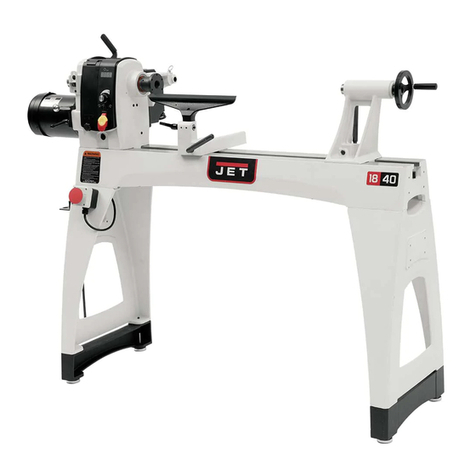
Jet
Jet JWL-1840EVS Operating instructions and parts manual
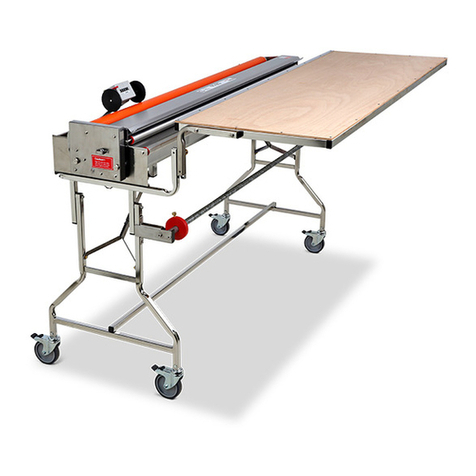
TAPO-FIX
TAPO-FIX Pasting Machine CB56 manual

Bolton Tools
Bolton Tools CEB Operation manual
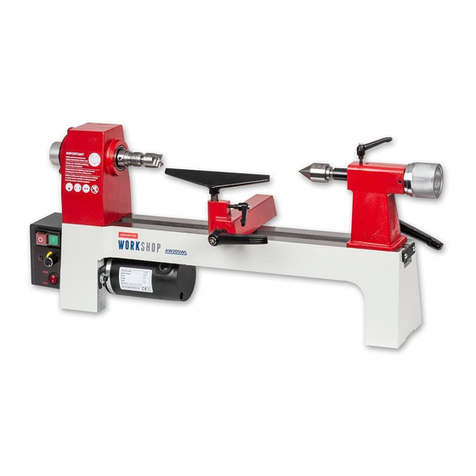
Axminster
Axminster WORKSHOP AW205WL Original instructions

Bench Power Tools
Bench Power Tools ML10001 owner's manual
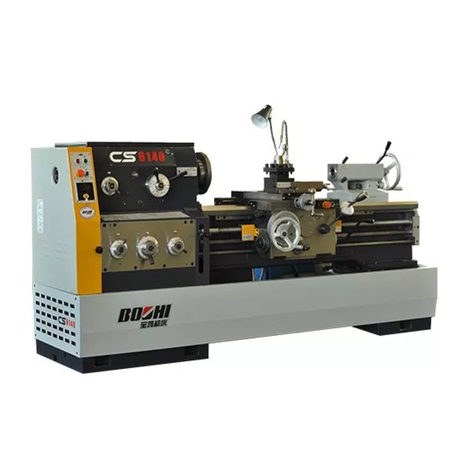
Bochi Machine Tool Group Co.
Bochi Machine Tool Group Co. CS6140 Series Operator's manual
